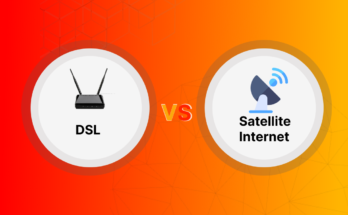We must know the distinctions between latency and bandwidth in the recent digital world. If you are fresh to the computer networks stream, you may be assuming what these two words mean and how they are attached. In this write-up, we explore what latency and bandwidth are and browse how they affect each other. We will also decide how to enhance and calculate both latency and bandwidth and offer a few wonderful practices for analyzing them. So. let’s begin!
What is Bandwidth?
Bandwidth is the much data that can be supplied between two points in a provided time. It is commonly calculated in bits per second (bps) or megabits per second (Mbps). The bigger the bandwidth, the quicker data can be supplied. It’s because a bigger bandwidth enables maximum data to be delivered at once.

Bandwidth is significant because it understands the data supplying speed. The video will take more time to secure with low bandwidth while playing online video. For example, if you’re playing an online video, the video will take more time to load if the bandwidth is low. Also, if you are securing a big file, it will take maximum time if the bandwidth is low. Thus, the bandwidth is a significant reasonable in understanding data supply speed.
What is Latency?
Latency is the moment it takes for a data packet to move from one point to another. It is commonly calculated in milliseconds (ms). Latency is significant because it understands how rapidly data can be obtained. The sport will have much disturbance if the latency is at maximum while playing an online sport.

Latency is also significant because it impacts the user experience. If the latency is at its peak, it can result in poor user experience because of slow loading lag and times. Thus, latency is a significant reason for understanding the user experience.
How are Bandwidth and Latency Related?
Latency and Bandwidth are nearly engaged because both of them impact data supply speed. As we mentioned previously, bandwidth understands the maximum amount of data that can be delivered quickly, while Latency understands how rapidly data can be obtained.
Thus, if bandwidth is low, it will take more time to supply data even if the latency is less. Equally, if the latency is maximum, it will take much time to accept data even if the bandwidth is more. This, both latency and bandwidth are significant reasons for understanding the data supply speed.
What are the Key Differences Between Bandwidth and Latency?
The major dissimilarity between latency and bandwidth is that bandwidth delivers maximum data rapidly while latency receives data quickly. Thus, bandwidth is much associated with the data transfer size, while latency is much associated with data transfer speed.
Another major distinction is that bandwidth is commonly calculated in bits per second (bps) or megabits per second (Mbps), while latency is commonly calculated in milliseconds (ms). Thus, bandwidth is calculated in a bigger unit of destination than latency.
How Does Bandwidth Affect Latency?
Bandwidth affects latency because it supplies data quickly. If bandwidth is low and consumes more time to supply data that will result in huge latency. On the other side, if the bandwidth is big, it will take a short time to deliver data, which will result in low latency. Thus, bandwidth is a significant reason for understanding latency.
How Does Latency Affect Bandwidth?
Latency impacts bandwidth because it understands how rapidly data can be obtained. If the latency is maximum, it will take more time to obtain data which will result in low bandwidth. On the other hand, if the latency is low, it will take a low moment to obtain data which will result in a bigger bandwidth. Thus, latency is a significant reason for understanding bandwidth.
How to Measure Bandwidth and Latency?
Various services and equipment are present to calculate latency and bandwidth. Make use of the device to estimate your internet speed. This will deliver your latency and bandwidth signal.
Make use of equipment such as Pingdom to estimate the website latency. It will give you a signal of the website’s reaction to your requests.
How to Improve Bandwidth and Latency?
Multiple steps are present to exceed bandwidth and latency. First, update your internet connection to a faster speed. Also, you can exceed your bandwidth and reduce your latency.
You can also move to a faster web hosting provider. It will also exceed your bandwidth and decrease your latency.
Third, you can analyze your website for quicker loading speeds. It can be performed by analyzing simplifying code, pictures and utilizing a content delivery network (CDN).
Lastly, you can apply compression strategies and caching to decrease data moved. It will reduce your server load and exceed your bandwidth and latency.
What are the Best Practices for Optimizing Bandwidth and Latency?
The awesome exercises for monitoring bandwidth and latency are given below.
- Update your internet connection to a maximum speed.
- Shift to a quicker web hosting provider.
- Analyze your website for quicker loading speeds.
- Apply compression and caching techniques.
- Analyze your latency and bandwidth regularly.
By going through such wonderful practices, you can crucially enhance your website speed and the user experience.
Conclusion
Bandwidth estimates the data supply rate while latency understands time late in data supply. Understanding the associations and dissimilarities is important for monitoring network performance and user experience. Bandwidth and latency are two crucial measurements that choose network performance. By consistently enhancing and calculating both latency and bandwidth by utilizing top practices, you can confirm smooth data supply and improve complete network reliability in digital time. If you want to check out Best Internet Providers in USA. You can visit Club HDTV OR Call us at +1(855)352-5313.
FAQ’s
A. While bandwidth measures the amount of data that can be transmitted per unit of time, latency measures the amount of time it takes for that data to travel from its source to its destination. In other words, bandwidth is about how much data can be transmitted, while latency is about how quickly the data can be transmitted.
A. High bandwidth allows for faster transfer of large amounts of data, such as video or audio streaming, downloading files, or uploading content. This can result in faster loading times and better overall performance.
A. High latency can cause delays in the transmission of data, resulting in slow loading times, buffering, and lag when using applications that require real-time communication, such as video conferencing or online gaming.
A. There are several online tools available that allow you to test your internet speed, including bandwidth and latency. Some examples include speedtest.net, fast.com, and pingtest.net.
A. Yes, there are several ways to improve your internet performance, including upgrading your equipment, optimizing your network settings, using a wired connection instead of wireless, and choosing an internet service provider with a higher bandwidth or lower latency.





